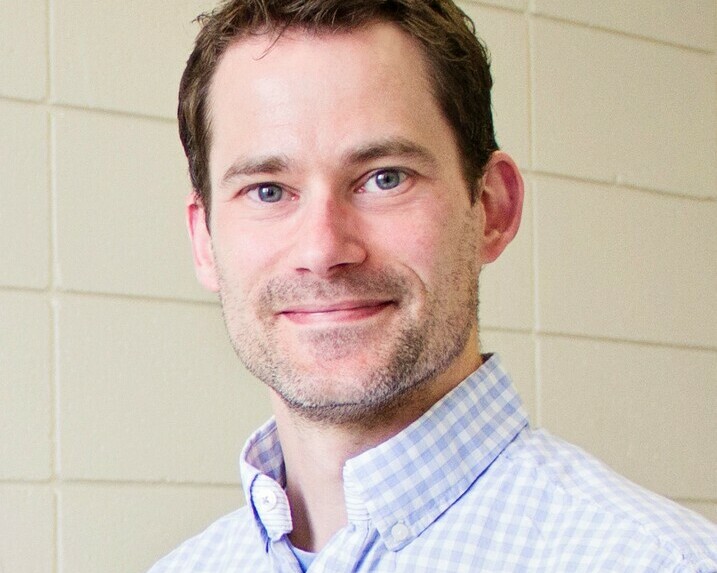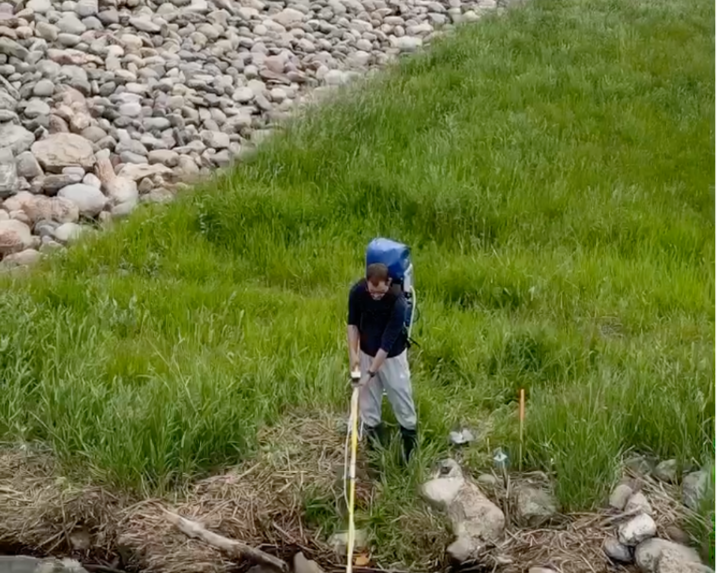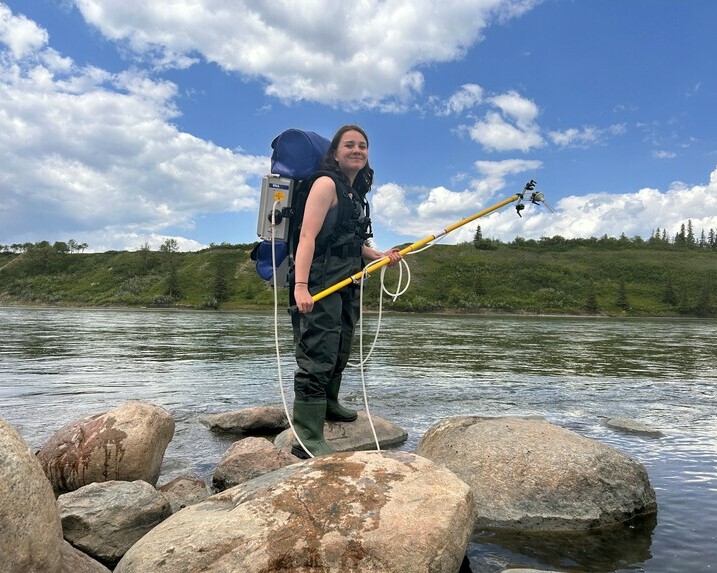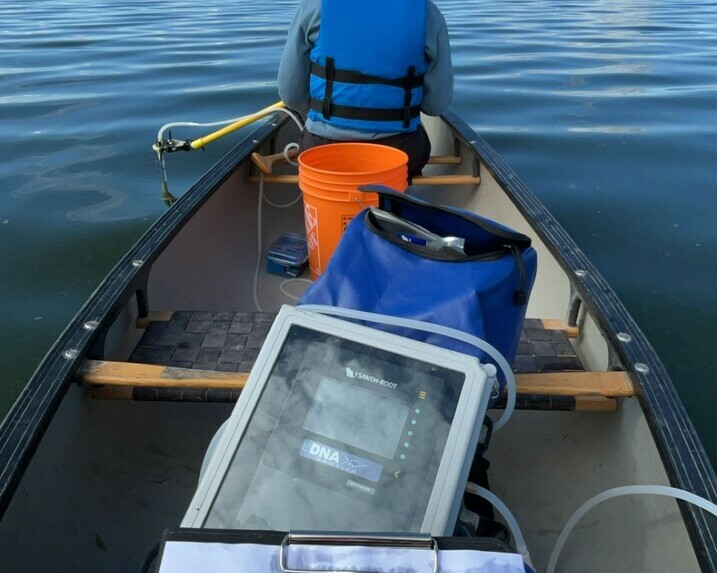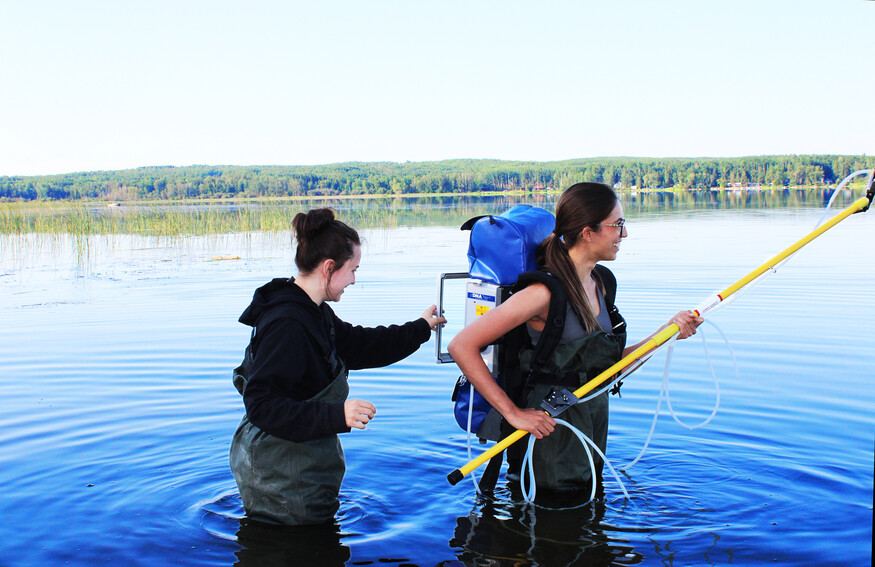
eDNA is a rapidly evolving field that helps communities and governments keep a close watch on where and when invasive species may be encroaching on waterbodies. It's also a way to detect whether a rare or threatened aquatic species may still be around. Read more about how eDNA has been used in Alberta - and how the NSWA has jumped into the 'gene pool'.
TOO GOOD TO BE TRUE?
When Dr. Patrick Hanington first encountered environmental DNA (eDNA) testing, he thought it was too good to be true. But, after almost a decade of using this method to search for specific aquatic organisms, Hanington says he’s lost his skepticism.
When whirling disease, which is caused by an invasive fish parasite, was first detected in Alberta’s national parks, Alberta Environment began to focus on the use of eDNA surveillance for invasive species. Hanington’s background in parasitology and fish immunology made him a natural fit for the project. Partnering with the province, Hanington’s lab (under the University of Alberta’s School of Public Health) developed the eDNA test for whirling disease – and became the testing site for these samples.
WHAT IS eDNA & WHAT DOES IT TELL US?
Hanington defines eDNA as any DNA released into an aquatic ecosystem by an organism. This can happen through spawning, feeding, skin or slime being sloughed off, excretion, or death and decomposition. Water, and sometimes sediment/substrate, is passed through a special filter that binds the eDNA. The eDNA can then be purified and used to assess for the presence of specific organisms using techniques like quantitative polymerase chain reaction (qPCR).
qPCR TESTING: HIGHLY SENSITIVE & A QUICK TURNAROUND
A qPCR test requires you to create and validate a specific test for your organism of interest. This means that the organism’s DNA has already been characterized and submitted to a global database. The analysis looks at a small section of a specific gene that distinguishes the species of interest from all others. While this method doesn't tell us anything about the abundance of that species nor even if they are still present, it is a great tool for broad geographical monitoring. It is very specific for the target organism, and is incredibly sensitive – traits that lend credibility to eDNA/qPCR-based monitoring for invasive species, which are often present in low abundance during the initial invasion process.
An important step when designing eDNA tests is to ensure that validation happens regionally. Hanington says this is because some organisms may be closely related to native species and not have enough differences within the gene to distinguish them from each other, resulting in a false positive. He uses a theoretical example, “If the test for a zebra mussel cross-reacted with a native pea clam in Alberta, that wouldn’t be helpful because we’d be ‘detecting’ invasive mussels in all kinds of areas that don’t have them.” Fortunately, this isn’t the case for Alberta’s native mussels.
Hanington’s lab can now test for over 30 different organisms, most of which are invasive to Alberta and some of which are at-risk species. This large repertoire of available qPCR tests allows for a comprehensive assessment of aquatic ecosystems based on the priorities of specific locations or groups. The other advantage of the qPCR method is its quick turnaround. Hanington shares how a motto around invasive species eDNA programs has become “Early detection, rapid response”, and adds that the qPCR method facilitates this as they can now “have a result for up to eight different invasive species within 24 hours.”
THE MUTUAL BENEFITS OF PARTNERSHIPS
While also growing internal capacity for the work, Hanington’s lab has continued to develop partnerships. These include the Alberta Environment and Protected Areas (AEPA) invasive species program, as well as municipal partners such as the City of Calgary. Hanington notes, “We’re just starting to get partnerships up and running in the City of Edmonton.” Non-profit organizations such as the Alberta Lake Management Society, NSWA, Alberta Invasive Species Council, and Indigenous communities are among other partners.
Over the past five to ten years, many communities and organizations across the province have recognized eDNA for its role in detecting both invasive species and Species at Risk (SAR). But while communities or industries may have the capacity to collect the samples, it’s much harder to find places with the capacity and skills to do the analysis work. Hanington’s lab is one of a small number of facilities currently focused on growing and advancing the eDNA field within Alberta.
Along with partnerships with the Alberta Government, the Hanington lab has partnered with Alberta Innovates and Alberta Lake Management Society (ALMS) to use community-based science for this eDNA work. As with most citizen science, it allows for the simple but geographically broad aspect of the work to be done by community partners, while those with the expertise can be in the laboratory doing the analysis.
NSWA’S WORK WITH eDNA
NSWA first partnered with the Hanington Lab and the GOA last year to sample for the early detection of invasive species, with a particular interest in Goldfish and Prussian Carp as they have infested a handful of waterbodies in the watershed. NSWA’s Kelsie Norton says, “This eDNA sampling is a pilot project that provides a method to detect invasive species before they can be seen and potentially become a problem.” They also did some metabarcoding (another eDNA analysis method that allows scientists to discern all the different organisms in a single sample) to see what fish species are present at various places along the mainstem and some tributaries.
Norton explains how NSWA’s involvement with the Heritage River project gave the NSWA’s former Watershed Coordinator, Rosey Radmanovich, an idea. She suggested that the NSWA use funding from the Heritage River project to hire two Indigenous Summer Field Research Technicians to offer eDNA sampling in-kind and to broaden and deepen relationships with Indigenous communities. This summer, Emily Specht and Caitlin Hilsen-Ashford were hired to complete the eDNA sampling, some of which happens alongside several First Nations Communities in our watershed.
In addition to eDNA sampling, Specht and Hilsen-Ashford were also trained under the CreekWatch program and met with Hanington at his U of A lab. Hanington demonstrated how best to use the sampler, answered questions about eDNA, and explained the science behind how the DNA is extracted and analyzed once in the lab.
GETTING THEIR FEET WET: 2024’s SUMMER FIELD RESEARCH TECHNICIANS
Emily Specht has completed a diploma in Conservation Biology at NAIT. She says that during one of her field courses, she was able to see the qPCR backpack and was given a brief overview of how it works. “I was quite excited to actually be able to get my hands on it.”
Hilsen-Ashford is in a program that combines Environmental Sciences with Native Studies at the University of Alberta and hopes to highlight Indigenous epistemologies within sustainability and conservation. “I saw this as a really good way to start learning about the needs of people in First Nation Communities and to start seeing what I could do to start meeting those needs. We’ve had opportunities with water sampling on the reserves to see what they’re doing, what’s important to them. I was really hoping to get to do something like this.”
When doing onsite CreekWatch sampling, the technicians test for phosphorus and other parameters that provide insight on water quality. They take field notes on things such as colour of the water, any visual cues, smells, or visible signs of invasive species. “We also note turbidity, how anthropogenic the shoreline is, and identify as many plant and animal species as we can,” says Hilsen-Ashford.
Specht says, “We note boat launches or natural creek areas – boat launches and beaches have a higher amount of activity coming in and out of the water, so there is more chance for invasive species.” They’ve travelled to a wide range of places throughout the watershed, but targeted recreational lakes such as Wizard Lake, Lac Ste. Anne, Mayatan and Wabamun Lakes because of their higher levels of human activity and contact.
STORIES FROM THE FIELD
Specht noted how different the lakes out in the eastern part of the watershed were from those located west of Edmonton. “Around Edmonton, they’re really full of algae; out east, they’re a bit better. I’m excited to go west to the mountains.” She adds, “I’ve never noticed how much the water quality changes between places as much as I have this summer.” And that includes places they revisited throughout the summer that can change as the weather heats up and rain does or doesn’t contribute runoff.
When the Field Technicians go out to First Nations Communities, they’re meeting up with representatives who are already working on various water-related projects. A few weeks ago, the technicians travelled to Whitefish Lake First Nation, in the eastern part of the watershed. “One of their lakes within the community has lost 80 hectares of water recently; it’s been pretty extreme. They’re losing a lot of spawning grounds, so they’re doing a habitat assessment,” says Hilsen-Ashford. “They have different projects going on and we can see what they’re doing and then use the eDNA to help support that [ecosystem knowledge] where we can. It’s been really interesting getting to make those connections.”
NSWA also partnered with Alexis Nakota Sioux First Nation and Elk Island National Park (Parks Canada) to conduct eDNA sampling. Alexis First Nation already has its own water quality monitoring program (Wakâ Mne Science and Culture Initiative), so Norton, Specht and Hilsen-Ashford were able to go out on the lake with their technicians. While they were canoeing back to shore, someone spotted a Western Grebe. An avid birder, Specht tried to capture a photo of the bird when they were back on shore. Unfortunately, it had moved too far away. “There were at least three adult Western Grebes - and potentially chicks - but it’s hard to tell from the photos,” she says. This was an exciting moment for Specht, as this rare grebe is categorized as threatened under the Wildlife Act.
TECHNICIAN TAKEAWAYS
Asked about memorable moment or experiences, the technicians both note how much they’ve enjoyed seeing different kinds of waterbodies and ecosystems throughout the NSR watershed. They’ve also enjoyed all the people they’ve connected to through sampling and various outreach events.
Specht says she was especially interested in an article she read about how eDNA was used to identify Indigenous places, based on a tree that is significant within Indigenous culture. This work is done by taking samples from the substrate (underwater ‘soil’) and provides an archive of the many organisms that have lived there historically. Specht was impressed that eDNA can be used as both an environmental - and cultural anthropological - archive.
The biodiversity Hilsen-Ashford witnessed this summer inspired her. “I want to preserve this. I want to make sure that we know as much as we can about it, so we don’t lose it without even realizing. That’s been reinforcing the importance and the value of the diversity that we have here. That has been one of my biggest takeaways.”
LINKS
To learn more about what you can do, see the GOA's page on Aquatic Invasive Species in Alberta or see Alberta Invasive Species Council (abinvasives.ca)
Click here for the "Aquatic Invasive Species Pocket Guide". This provides a list and details about each species.
To learn more about why goldfish as invasives, click here. For ideas about what to do with a goldfish you can no longer care for, see this City of St. Albert “Goldfish Management” page
